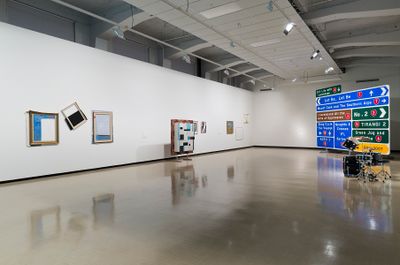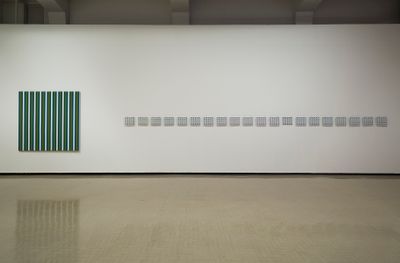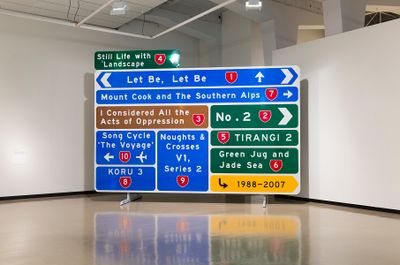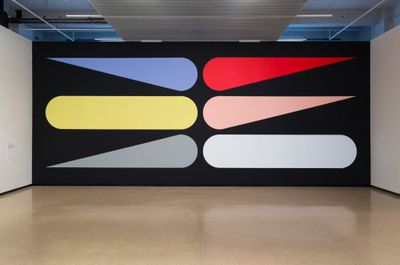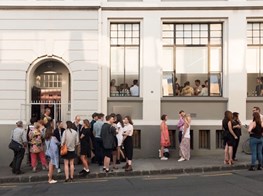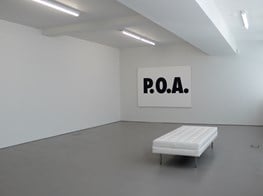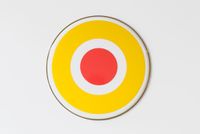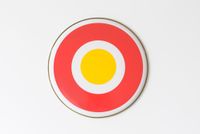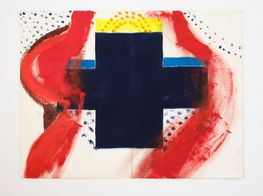Julian Dashper: Calling the future
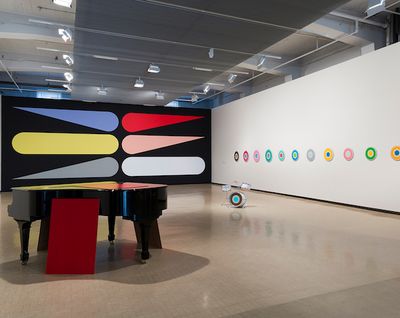
Installation view: Julian Dashper & Friends, City Gallery Wellington (5 December 2015–15 May 2016). Courtesy City Gallery Wellington. Photo: Shaun Waugh.
Julian Dashper was born on a leap day in 1960. Monday 29 February 2016 would have been his fifty-sixth birthday. Or his fourteenth, depending on how you work the calendar calculations. Simultaneously older and younger, Dashper's leap year birth anticipated the basic elements of his art practice: absence and presence, addition and subtraction, a quirk in the system of time. He died on 30 July 2009.
Known for his brilliantly wry and playful conceptual works, Dashper was a key figure in the New Zealand art world of the late 1990s and early 2000s. For curator Robert Leonard, his art practice is important because it spanned a transitional period in New Zealand's art history. Dashper brokered a shift from mid-century regionalist painters who were interested in nationalist artistic themes, to a group of younger artists who embraced different media and modalities, but also pursued the discourses of a globalised art world. This was the subject of Leonard's exhibition Julian Dashper & Friends (5 December 2015–15 May 2016) at the City Gallery Wellington—a show which brought together a selection of artists working before and after Dashper, each of whom influenced or was affected by his art and the aesthetic practices of his life.
An artist with a keen interest in art history, Dashper's significance is difficult to encapsulate. By all accounts, his witty and concise works of art were just as important as his interactions within the New Zealand art community. Dashper was a generous thinker, curator, conversationalist, friend, and a teacher. This was an artist who thought deeply about art, but also about the wider workings of its encounter: the systems, procedures, connections, and friendships of the world that sustained its creative and conceptual impulses.
Dashper's big work of the 1990s was a series of drum-kit installations that would become known as The Big Bang Theory (1992-3). Installed in different venues around New Zealand, Dashper's drums celebrated some of the country's best-known artists as though they were 1960s pop bands. The Woollastons, The Colin McCahons, The Anguses, The Hoteres, and The Drivers paid homage to a selection of mid-century artists—mainly painters—whose landscapes and abstractions were well established within the canon of New Zealand art history.
When I first came across Dashper's drum-kits in the early 2000s, I had to laugh. These works addressed the weighty legacy of New Zealand's art history through the poppy, light-hearted excitement of sixties band culture. The heady pop-infused Beatles nostalgia of the Boomer generation met the resolute seriousness of late-modernist abstraction. I imagined the broodingly brilliant abstract painter Colin McCahon twirling a paintbrush in hand, like Ringo might have spun his drumstick. Here, Dashper was characteristically funny and shrewdly precise. Works such as this one were absurd without being camp, and clever without being glib. My laughter has always been accompanied by a certain respectful intimidation. Dashper's art jokes achieved that clever mixture of sharpness and elegance.
Of course, what The Big Bang Theory really achieved was a conceptual critique that was also celebratory; neither an outright dismissal of these painters nor a naïve valorisation. By the 1990s, McCahon's art historical legacy was serious business. As an artist working in New Zealand, it was difficult to make a move without been drawn into its discursive orbit. Dashper's work didn't contest or challenge this legacy, but it did relieve us of its tremendous solemnity. Dashper realised that the history of art was a system—and a serious one at that—but a system that was robust enough to be teased, joshed and lampooned.
The much younger artist Dane Mitchell shared Dashper's interest in messing with the system. Mitchell was an art school student of Dashper's in the late 1990s and many of his works similarly seek to impishly play off the inner workings of art world. Included in Leonards' Julian Dashper & Friends, Mitchell's controversial work Collateral (2009) won the annual Trust Waikato National Contemporary Art Award as a 'pile of rubbish' that simply consisted of the stuff used to package the works of other contenders. Outside of the inevitable furore it provoked in the mainstream media, Mitchell's piece sustained Dashper's precise and sparing engagement with the work of art as a conceptual idea and the work of art as physical thing—in this case, a collection of packaging waste.
Talking to Mitchell about Dashper's legacy, we both recalled our favourite work his—one that is similarly spare, minimal and clever. The first iteration of Future Call was performed for a 1994 exhibition in Topolò, Italy and would be repeated in different international locations until 2006. It involved a series of phone calls being made from New Zealand to the exhibiting gallery in Italy. The work establishes a quick-witted temporal joke that shares an affinity with the artist's leap year beginnings. In Italy, the much earlier New Zealand time zone meant that the future was effectively making a toll call to the past.
Mitchell remembers participating in subsequent performances of this time-twisting piece: 'When I had just finished art school, Julian actually asked me to make the call for him for a show in Europe. I had to get up at three in the morning so I could start calling during this opening event on the other side of the world. I remember having this fantastically weird experience of performance anxiety about making a phone call that was not going to be answered.'
By the late 1990s, Dashper had developed an affable network of international galleries, artists, and art-friends. A few weeks after meeting Mitchell, I called one of these friends, the Dutch non-objective painter Jan van der Ploeg, at his studio in the Netherlands. Van der Ploeg made the journey out to Wellington to develop a site-specific wall painting for Julian Dashper & Friends. He insists that while Dashper's intellectual interest in abstract art was certainly influential, it is the New Zealand artist's pursuit of conversation, the exchange of ideas and the careful maintenance connections that also remains significant. On the question of influence, van der Ploeg answers:
'I cannot say exactly where it is. One thing I can suggest is that Julian actually encouraged me to do the wall paintings—and it was for a very practical reason. He said: If you make a wall piece, you don't have to ship that big painting to different places. Just bring the idea. All you need is a few brushes—it is a very simple thing to do.'
Like Mitchell, van der Ploeg is bursting with stories about Julian, his friend and fellow artist, their galleries, their art practices, their children, and their lives. There are too many stories to record here. But one thing that strikes me is that, even when he was alive, Dashper was always associated with stories: quirky happenings, likes and dislikes, narratives of chance, happenstance and coincidence.
The story that circulated through my art school friends comes from a time when Dashper was a tutor in the visual studies department at AUT University. It is nearing the end of term and Dashper gives a lecture to a group of stressed-out students. The lecture is about the artist who leaves something for viewers to take home with them—perhaps a sheet of paper with a few words, carefully folded into a small catalogue. These words were important to Dashper, but so too was their medium. Mid-lecture, he rather dramatically pulls a credit card from his wallet to demonstrate the absolute best way to fold this sheet of printed-paper. Fingers leave smudge marks, but the flat end of card creates a perfectly crisp crease.
Dashper's point? Your art is important, but just as important are the words that surround it. And even more important than that is the crisp white edge of a perfectly folded piece of paper. This was detailed, almost pedantic stuff, but for a young artist it was golden advice. However nominal, the flawlessly folded paper catalogue suggested that you were serious; that you meant business and that you, too, were ready to play the game of art.—[O]

